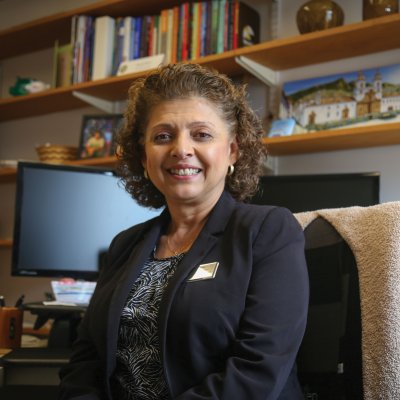Becoming a Hispanic Serving Institution
This article appeared in the Spring/Summer 2022 issue of The Bulletin.
By Brian Yoder Schlabach ’07
How does a small, historically Mennonite college in Northern Indiana find itself on the brink of becoming a Hispanic Serving Institution (HSI) in 2022 when only two percent of undergraduate students identified as Latino just 15 years ago?
The journey is really three interconnected stories, according to David Lind ’97, professor of sociology.
The first is a story about the college’s faith-based commitments to social justice, diversity and equity. The college’s goal to diversify the student body and truly serve Latino students is guided by its Christian commitments to social justice and the core value that calls students and faculty to be global citizens.
The second is a story about changing demographics in its surrounding community — Elkhart County, Indiana. Drawn to manufacturing jobs and a growing Spanish-speaking network of communities, Latino families have been arriving and putting down roots in the region for decades. In 2014, Goshen Community Schools became a majority-minority district, with 50.1 percent of students identifying as Hispanic.
And the third is a story around the college’s relationship with Lilly Endowment, Inc., and the offer of a transformational grant for the institution. In the fall of 2006, President James Brenneman ’77 accepted what would be one of the defining initiatives across his two terms: a $12.5 million grant approved and funded by Lilly Endowment, Inc., for what became known as the Center for Intercultural Teaching and Learning (CITL). The grant established a new center with three main goals of making college education more accessible to Latino students, creating an intercultural learning community and researching the changing ethnic composition of the community.
With the grant support, Goshen College ramped up recruitment and retention efforts for students of color — with a particular focus on Latino students — alongside the research component. The college began to hire more Spanish-speaking faculty and staff, and held Spanish-language workshops for Latino families at local high schools, answering questions for first-generation students and families who were considering college for the first time. And the college set about finding ways to not only reach more Latino students, but to support them in new ways as they completed their degrees.
Now, President Rebecca Stoltzfus is leading the charge as Goshen College is in the final leg of the journey to becoming an HSI. “From the start, Goshen was created to provide access to rural youth and to educate first-generation Mennonite youth,” she said. “It’s been part of our identity to be a place that serves first-generation students and opens the door to higher education.” As Goshen College continues to prioritize Latino student enrollment and support in new and ever-changing ways, leaders have committed to becoming a Hispanic Serving Institution.
This article is a shortened version of one published in the May 2022 issue of The Hispanic Outlook on Education magazine.
A Q&A with Rocio Diaz ’14
We talked to Rocio Diaz ’14, director for community engagement & adult outreach, about Goshen’s journey amidst changing demographics, perspectives regarding Latino education and where Goshen can go from here. Rocio has been a Goshen College parent of two graduates, an employee working in intercultural education (initially hired as the administrative assistant for the Center for Intercultural Teaching and Learning) and then a student/alumna herself. This interview has been edited for clarity and length.
Q: How did you and your family end up at Goshen?
A: My neighbor was working at Goshen College, and convinced us to visit when my daughter was ready for college in 2006. We thought ‘let’s just go and see how they can help us.’ We liked the convenience of my daughter staying home and not having to drive too far to attend college, so we enrolled her at GC.
Q: How did the Center for Intercultural Teaching and Learning support Latino students?
A: We saw all the ways that [Latino students] needed support because of all the issues that they face when they’re here. They still have to work sometimes full-time jobs or help with siblings at home, or translate for their parents. And often their families don’t understand how much work college is.
Q: In order to be eligible for HSI status, undergraduate enrollment must be at least 25% Hispanic students, along with several other criteria. What do you think about Goshen potentially becoming a Hispanic Serving Institution?
A: Well, we’re in the middle of a Latino community, Latino students are all around us, and I think that we are already serving those students and helping them achieve and accomplish their education goals. So it makes sense.
Q: How else were you reaching the Latino community?
A: If you want to reach the Latino community or bring students, you have to think about the whole family and not just that one student that you want here. The focus was more on Latino families and not just juniors and seniors because we’re changing the mindset of the parents, so the parents start imagining their kids getting education.
Q: How have you seen the Latino student experience here at Goshen evolve since you started?
A: I’ve seen a higher number of students participating in different clubs and different organizations, and I think it was mostly because of the academic support and also the mental and social support students received. We still try to connect with the students and encourage them so they feel more empowered.




